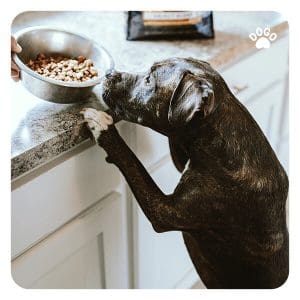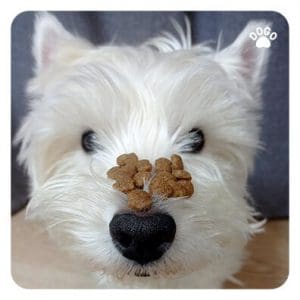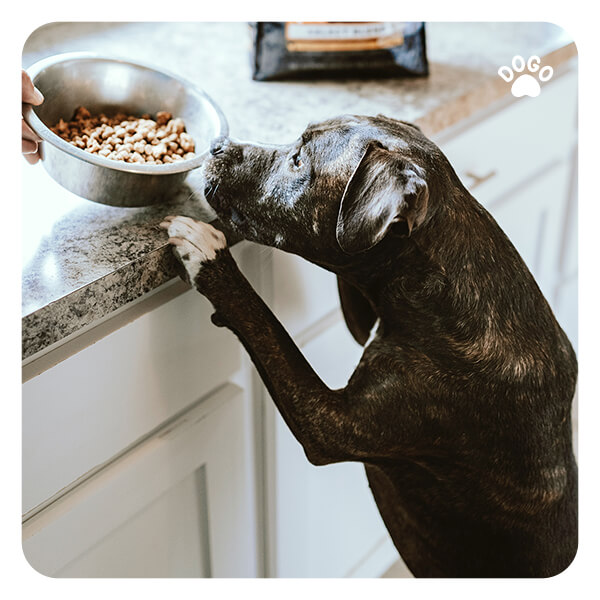Stealing food from the table is one of the most annoying and frequently encountered problems. This behavior is usually the result of a lack of consistency and established rules at an early age. The pattern is similar to the problem of begging for food. When a cute puppy joins our family, we want to give them as much as possible and make them like us. Therefore, we spend a lot of time with them, play with them, and give them delicious things to eat. If these are dog treats, that’s great, but if we start to provide them with pieces of meat from the table, this is where the problem begins.
 At this moment, our dog learns that there are often much tastier treats on the table or in our hands, and, apart from begging, they can try to get the food themselves. They do it by jumping on the table or tabletop or by grabbing the food from our hands. While adults can resist this behavior, children may have trouble doing so, and they become easy targets for attempted stealing.
At this moment, our dog learns that there are often much tastier treats on the table or in our hands, and, apart from begging, they can try to get the food themselves. They do it by jumping on the table or tabletop or by grabbing the food from our hands. While adults can resist this behavior, children may have trouble doing so, and they become easy targets for attempted stealing.
Why Do Dogs Steal Food?
-
Gluttony
Not many dogs can resist the smell of fresh meat on the table. In fact, if we have a shelter dog or one that has previously lived outside, they may steal food to spare out of fear that they will suddenly run out of it. This is an instinct, which, even though dogs are already far from being wolves, some part of them remains in our furry friends.
-
Improper Diet
If your dog receives too small a daily portion of food, they will try to get the missing calories independently. In the case of a poorly balanced diet, your dog may try to make up for deficiencies in their body by snacking on our snacks.
-
Boredom and the Desire to Play
If the dog has learned that we immediately pay attention to them whenever they take something and chase them, they are simply having fun. Pets often provoke their parents to interact with them because they lack entertainment. Our responsibility as dog parents is to provide for all of our dog’s basic needs, including play.
-
Medical condition
In some cases, dogs may steal food due to underlying medical conditions such as diabetes, Cushing’s disease, or hyperthyroidism. These conditions can cause increased hunger and food-seeking behavior in dogs. If your dog’s stealing behavior persists despite training and behavior modification, it is important to consult with your veterinarian to rule out any underlying medical issues.
Clear Rules
 The foundation, as always, is teaching basic obedience and clearly defined rules in the home from an early age. If we want to avoid such problems, above all, every household member should follow the rules. In this case, the most important is not to give food to the dog at the table. We should never allow the dog to climb on the countertops and table. When the pet is small, they may look cute; however, remember that the dog will grow up. They will start reaching out and sneaking things, and it can be dangerous to their health.
The foundation, as always, is teaching basic obedience and clearly defined rules in the home from an early age. If we want to avoid such problems, above all, every household member should follow the rules. In this case, the most important is not to give food to the dog at the table. We should never allow the dog to climb on the countertops and table. When the pet is small, they may look cute; however, remember that the dog will grow up. They will start reaching out and sneaking things, and it can be dangerous to their health.
It is important to ensure that your dog has access to their own designated feeding area and that they are fed at regular intervals. This can help prevent your dog from feeling the need to steal food from the table. Additionally, providing your dog with appropriate toys and activities can help prevent boredom and reduce the likelihood of them engaging in inappropriate behavior such as stealing food. It is also important to supervise your dog at all times and to keep potentially harmful foods out of reach. This can help prevent accidents and ensure that your dog stays safe and healthy. Finally, if you are having difficulty preventing your dog from stealing food, consider seeking the help of a professional dog trainer or behaviorist who can provide additional guidance and support.
The Most Important Commands
For a dog who already has a habit of stealing food, learning the commands “leave it” and “give back” is crucial. Both commands teach your dog self-control and release, which is extremely important in everyday life. You can find a detailed description of the commands in the Dogo App. Learning is divided into two stages.
-
Leave it
We use the learned command “leave it” when we see that the dog is lurking at our food. If the dog lets go, we praise them enthusiastically and reward them. It can be their treat, but give it to the dog’s bowl so that they don’t associate it with the food on the table. A reward in the form of play is also a good option. Practice this command in set situations, i.e., leave something not very attractive on the table and leave the room, but observe the dog from afar. If the dog did not try to approach the food, come back and give them something extra. On the other hand, if we see that the dog is trying to eat, issue a command “leave it.”
-
Give back
The command “give back” is especially important if your dog has already managed to steal something. Never chase your dog or take away the food (unless it is something toxic). Chasing the dog will only make it more fun for them – your dog will treat it as a game. However, taking the food from the dog’s mouth may damage your relationship and cause the dog to stop trusting you. A better alternative is to use a well-trained command or to replace the food with something more appealing.
Impulse Control
 Teaching your dog to ignore food is essential as well. We recommend trying out easy exercise:
Teaching your dog to ignore food is essential as well. We recommend trying out easy exercise:
- Clip your dog’s leash and set out snacks in various places around the house.
- Walk past them with your pup, but don’t let your dog near the treats.
- Control your pet with the leash. If your dog lets go, reward them with something tasty.
It must be something better than on the floor. The dog must learn that they get the best treats from us for good behavior, and it doesn’t pay off to steal. Check out our new program, “Impulse Control,” which, among other things, will guide you in teaching your dog to ignore food.
Final Tip
If your dog hasn’t mastered the commands 100% yet, remember to keep them from eating food from the table. Also, keep an eye on your dog when guests visits and around children, who often give dogs something good from the table. When you can’t control your dog, put away all the things that they can consume. If the dog can steal something from the table, there will feel rewarded and successful. Unfortunately, this may cause us to regress in our learning.



